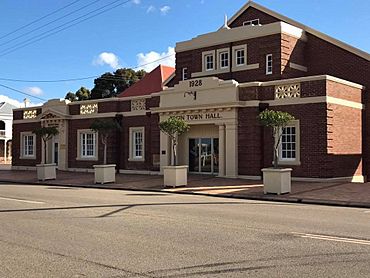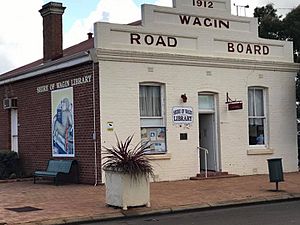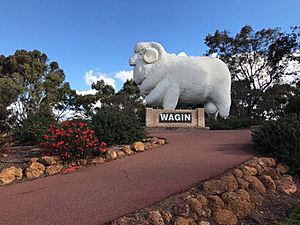Wagin, Western Australia facts for kids
Quick facts for kids WaginWestern Australia |
|||||||||
|---|---|---|---|---|---|---|---|---|---|

Wagin Town Hall
|
|||||||||
| Established | 1890s | ||||||||
| Postcode(s) | 6315 | ||||||||
| Elevation | 303 m (994 ft) | ||||||||
| Area | [convert: needs a number] | ||||||||
| Location | |||||||||
| LGA(s) | Shire of Wagin | ||||||||
| Region | Wheatbelt | ||||||||
| State electorate(s) | Roe | ||||||||
| Federal Division(s) | O'Connor | ||||||||
|
|||||||||
Wagin (say it: WAY-jin) is a town in the Wheatbelt region of Western Australia. It is about 225 km (139.81 mi) south-east of Perth. You can find it on the Great Southern Highway, between Narrogin and Katanning. Wagin is also on State Route 107. The main jobs here are wheat farming and raising sheep.
Contents
A Look Back: Wagin's History
The name Wagin comes from Wagin Lake, which is a salt lake south of the town. This lake is usually dry. The name is from the Noongar people, who are the traditional owners of the land. It means "place of emus" or "where the emu sat down". A surveyor first wrote down the name between 1869 and 1872.
Early Explorers and Settlers
The first European explorer to visit this area was John Septimus Roe. He was the Surveyor General of Western Australia. He passed through in 1835 on his way from Perth to Albany. For many years, only a few settlers lived here. They made a living by cutting sandalwood trees and looking after small groups of sheep. Land was given to farmers in the Wagin area starting in the late 1870s.
How Wagin Grew
The town of Wagin started to grow after the Great Southern Railway was built. This railway was finished in 1889. The town was first called Wagin Lake.
The first post office and telegraph building was finished in 1893. It was designed by George Temple-Poole. This building was later replaced by the one you see today, which was built in 1912. The new building was designed by Hillson Beasley. The old building was then used as homes.
An Agricultural Hall was built by 1896 and opened in December of that year. In 1898, Wagin was officially named a town, and the word Lake was dropped from its name. Another railway line was added on December 10, 1918. This line connected Wagin to Bowelling, on the Collie to Narrogin line.
In early 1898, about 175 people lived in Wagin. There were 125 men and 50 women.
Important Buildings in Wagin
- Saint George's Anglican Church: This stone church was built in 1900. It has a tower and was built in the Federation Gothic style. The land for the church was given by Frederick Piesse.
- The Palace Hotel: This hotel was built in 1905. It is a two-story building with large verandahs. It is located on Trudhoe Street. The first owner was Paddy B. Durack. More parts were added to the building in 1911.
- Wagin Road Boards Building: This building was constructed in 1912. For many years, it was home to the town library. In 2023, the library moved to the old Town Hall.
- Wagin Town Hall: Plans for the current town hall started in 1928. The first stone was laid in May 1928 by Sydney Stubbs. The building was finished in early 1929. It has a main hall for 600 people, a smaller hall for 250, a library, and council rooms.
Past Events
In 1934, Wagin had a big flood. The area received 5.4 inches (137 mm) of rain in a short time. This was the most rain in 20 years. Water more than 1 foot (30 cm) deep flowed through the Town Hall. It also went into businesses and homes along Tudor Street. The railway yards were flooded, and the railway dam broke.
In January 2022, Wagin was the closest big town to a series of earthquakes near Arthur River. The strongest earthquake happened on January 25, 2022. It was a magnitude 4.7 or 4.8 earthquake. It caused small damage, like cracks in walls, to some buildings.
Wagin Today
Wagin is one of the biggest towns in the southern Wheatbelt area. Every year, it hosts the Wagin Woolorama. This is one of Western Australia's largest agricultural shows. It happens in March each year and usually brings in over 30,000 visitors.
The Big Ram Sculpture
The Big Ram, also called the Giant Ram, is a famous tourist attraction in Wagin. It was built in Wetlands Park in 1985. The artist, Andrew Hickson, made the ram from fibreglass over a steel frame. The ram is 9 metres (30 ft) tall, 13 m (43 ft) long, and 6 m (20 ft) wide. It weighs 4 tonnes (3.94 long tons; 4.41 short tons). Thousands of people visit the park each year to see this huge ram. It is the second largest sculpture of its kind in the Southern Hemisphere.
Famous People from Wagin
Some well-known brothers who played league football came from Wagin. These include Murray, Harry, and Phil Riseborough. Also, Peter, Phil, and Wally Matera are from Wagin.
Wagin's Climate
| Climate data for Wagin, Western Australia (1970–2017) | |||||||||||||
|---|---|---|---|---|---|---|---|---|---|---|---|---|---|
| Month | Jan | Feb | Mar | Apr | May | Jun | Jul | Aug | Sep | Oct | Nov | Dec | Year |
| Record high °C (°F) | 44.0 (111.2) |
43.0 (109.4) |
40.5 (104.9) |
37.1 (98.8) |
33.2 (91.8) |
24.2 (75.6) |
22.7 (72.9) |
26.2 (79.2) |
31.8 (89.2) |
37.0 (98.6) |
40.4 (104.7) |
43.7 (110.7) |
44.0 (111.2) |
| Mean daily maximum °C (°F) | 31.1 (88.0) |
30.4 (86.7) |
27.7 (81.9) |
23.7 (74.7) |
19.4 (66.9) |
16.4 (61.5) |
15.3 (59.5) |
16.1 (61.0) |
18.2 (64.8) |
22.0 (71.6) |
25.8 (78.4) |
29.2 (84.6) |
22.9 (73.3) |
| Mean daily minimum °C (°F) | 14.6 (58.3) |
14.9 (58.8) |
13.5 (56.3) |
10.8 (51.4) |
8.0 (46.4) |
6.2 (43.2) |
5.5 (41.9) |
5.7 (42.3) |
6.2 (43.2) |
7.9 (46.2) |
10.7 (51.3) |
12.9 (55.2) |
9.7 (49.5) |
| Record low °C (°F) | 4.2 (39.6) |
4.6 (40.3) |
2.4 (36.3) |
0.1 (32.2) |
−0.7 (30.7) |
−2.2 (28.0) |
−3.0 (26.6) |
−1.3 (29.7) |
−1.4 (29.5) |
−0.5 (31.1) |
0.0 (32.0) |
2.4 (36.3) |
−3.0 (26.6) |
| Average precipitation mm (inches) | 12.8 (0.50) |
16.3 (0.64) |
20.6 (0.81) |
28.9 (1.14) |
54.4 (2.14) |
71.6 (2.82) |
69.9 (2.75) |
56.7 (2.23) |
41.2 (1.62) |
28.9 (1.14) |
18.1 (0.71) |
13.2 (0.52) |
431.9 (17.00) |
| Average rainy days | 1.5 | 1.6 | 2.2 | 3.7 | 6.7 | 8.9 | 9.5 | 8.5 | 6.7 | 4.8 | 2.9 | 1.6 | 58.6 |
| Source: Australian Bureau of Meteorology | |||||||||||||





